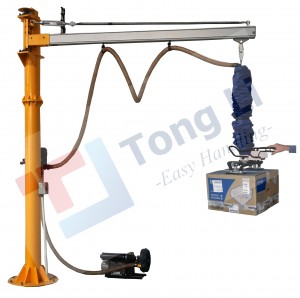A vacuum tube lifter is a mechanical device used for lifting and handling various types of loads, typically in industrial or manufacturing settings. It utilizes vacuum technology to create a vacuum seal between the lifter and the load, enabling it to lift objects without manual intervention or physical contact.
Here’s how a vacuum tube lifter generally works:
Vacuum Generation: The device is equipped with a vacuum pump or generator that creates a vacuum within the lifting tube or suction pad.
Attachment to Load: The lifter is brought close to the object to be lifted, and the vacuum system creates a seal between the lifter and the load’s surface.
Lifting Mechanism: Once the vacuum seal is established and confirmed, the lifter uses its mechanism to raise the load off the ground or from its current position.
Maneuvering and Transport: The lifted load can then be moved horizontally or vertically, depending on the design and capabilities of the lifter. Some vacuum tube lifters come with swiveling or tilting mechanisms for precise positioning.
Release: After the load is placed at the desired location, the vacuum seal is released, allowing the lifter to detach from the object.
These devices are commonly used in warehouses, manufacturing plants, logistics centers, and other industrial environments to handle a variety of items, such as boxes, cartons, sacks, sheets of metal or glass, and more. They offer advantages like increased efficiency, reduced risk of damage to the goods, and improved safety for workers by minimizing manual lifting.
Post time: Dec-18-2023


